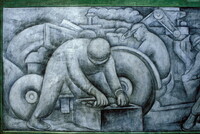Detroit Industry
Rivera, Diego

Download6A1-RD-DIA-A33_cp.jpg (638.5Kb)
Alternative Title
Detroit Industry Murals
Date
1932-1933Description
South wall, bottom panels, showing panels on the right side; The Detroit Industry mural cycle in the Detroit Institute of Arts is the finest example of Mexican muralist work in the United States, and Rivera considered it the most successful work of his career. The murals are a tribute to Detroit industry in the 1930s. It is one of the few major modern works to successfully incorporate representations of functional machines. Rivera transformed their physical power and practical design into dynamic images and sensual forms. In 1932, when Diego Rivera was well known in the United States as one of the leaders of the Mexican muralist movement, he was commissioned to decorate the walls of what was then called the Garden Court of the Detroit Institute of Arts. Although he was originally asked to paint just two of the largest panels, Rivera was so captivated by Detroit and the Ford Motor Company's River Rouge industrial complex that he soon suggested painting murals on all four walls. The project took eight months to complete. The only stipulation of the project agreement was that the theme of the murals should relate to the history of Detroit and the development of its industry. Major sections are based on Rivera's study of the Rouge; other sections are devoted to different industries active in Detroit at that time. The complete cycle combines the artist's love of industrial design and admiration for North American engineering with his philosophical opinions about industry's positive and negative contributions to society. Rivera painted all twenty-seven panels in the court himself. Source: Detroit Institute of Arts [website]; http://www.dia.org/ (accessed 7/5/2008)
Type of Work
fresco (painting)Subject
allegorical, cycles or series, engineering and industry, manufacturing, industrialization, manufacturing, Mexican Muralist, Twentieth century
Rights
Rights Statement
Licensed for educational and research use by the MIT community only